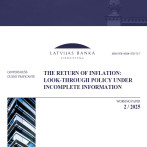Dynamics of global food prices does not point to a dramatic rise in food prices
August saw a continued rise in producer's prices - 0.6% over July and 7.0% year-on-year. The producer's prices of production sold on the domestic market and that exported have climbed almost at the same rapid rate. The rise in the producer's prices of exports was primarily caused by the producer's prices of food and paper, which is good news to businesses exporting these products, for thus they are ensured increased income. The dynamics of global prices continued to cause an upward price pressure domestically as well, as both the producer's prices of food and wood pulp products rose.
Referring to changes in global prices, certain producers and sellers are currently predicting that prices of food products may rise even several times over. The question is whether their arguments are based in reality and whether, against the background of rising global prices of energy resources and food, ungrounded expectations of price rises are not being encouraged. World Food and Agricultural Organization's (FAO) data on food price indices confirm the rise in world food prices, bit to a much lesser extent than currently rumoured in Latvia. FAO data indicate that in August the total food price index climbed a moderate 5% month-on-month. As inclement weather gives rise to worries about the world's grain supply, grain prices have risen quite rapidly: over a month they rose 12% and, since the lowest point in June, 20%. Milk prices, however, continued to drop at the monthly rate of 3%.
Speculations about world and thus also domestic food prices returning to the heights of their pre-crisis climb have also been heard. Yet FAO gathered information indicates that currently overall global food prices are 18% lower than at their highest point in June 2008, with grain and milk prices respectively 33% and 22% under the pre-crisis peak. While this information of course does not reflect a precise price dynamics faced by Latvian manufacturers, it does indicate the overall trend that does not indicate any dramatic price rise.
In the future, the food price developments in the world will depend on many hard-to-predict factors. Yet it can be expected that the continued uncertainty regarding the development of the US and the euro area and the slow and uneven recovery of global demand will slow any rise in food prices. FAO in its June report likewise predicts that in 2010 and 2011 the food stores in the world will continue to be large and thus the influence of supply factors on the rise of food prices should not be substantial.
The world food price dynamics is only one among several factors that influence domestic food prices. Manufacturers and merchants have to take into account a much lower demand than it was in the years of growing economy, thus the possibilities for raising prices are limited. Moreover, a lower price rate compared to a period of rapid growth can also be ensured by lower labour costs.
Textual error
«… …»






